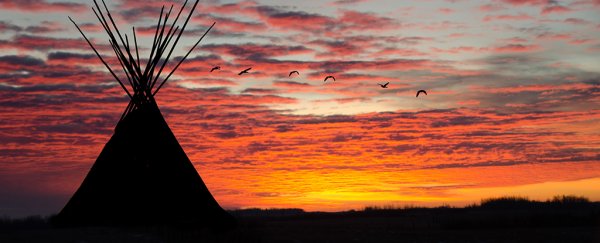An analysis of DNA collected from representative populations in China, Siberia, and the US has revealed the first peoples to call America home could have numbered as few as 250 individuals.
The study adds important detail to models describing how the New World was populated in the wake of the last great ice age, painting a picture of small family groups splitting and settling their way across the continents over thousands of years of migration.
Geneticists from the US and Brazil resequenced samples of DNA collected from individuals representing Native American tribes scattered across Central and South America.
They focussed specifically on nine non-coding sequences, comparing them with samples derived from 10 Siberian ethnic groups and 15 individuals from China.
These populations provide genetic stepping stones that allow researchers to work backwards and estimate the time and size of migration movements.
"It is difficult to go back in time to follow the populations, but we can characterise contemporary genetic diversity and estimate the mutation rates that have occurred in different regions," says Michael Crawford from the University of Kansas.
Crawford's past research in anthropological genetics describe a migration timeline stretching back 23,000 years, starting with a Siberian population settling in Alaska as ice sheets retreated open up new lands.
These founding families were in no great rush to explore their new home, spending as much as 8,000 years hanging around an exposed strip of land between Siberia and Alaska known as Beringia.
Those who remained behind passed their genes and culture onto a people who came to be the Athabascans, while communities who made their way deeper into the American continents became the Amerindians.
This slow progress was less a sequence of long marches into the unknown, and more about smaller clans pinching off from larger ones once things got a little too crowded, starting afresh nearby.
"It wasn't a matter of a group that announced, 'Let's go follow this one,'" says Crawford.
"It was a matter of population fission among hunters and gatherers."
This might not be a fast way to fill a continent, but given enough time a diverse number of interlocking cultures can evolve.
"After 15,000 years, you can put them all the way down in Argentina," says Crawford.
While the sequence has been understood, the exact numbers have never been clear.
One estimate put forward more than a decade ago suggested there were barely 70 people making up those first camps.
Computer simulations that churned through 100 million generations based on the genetic data indicated the first settlement could have contained as many as 4,000 individuals.
The most likely figures, though, estimated a population somewhere between 229 and 300 people.
That's a little more than 70, but it still wouldn't be enough to fill all of the seats on a Boeing 747-400.
A larger sample size and additional research using other genetic groups could further refine the number and provide a clearer snapshot of life on the road to America 20,000 BCE.
"Going from a few hundred founders to around 40 million inhabitants of the Americas, who eventually live under different environmental conditions to which they adapt, is pretty exciting stuff," says Crawford.
We couldn't agree more.
This research was published in Genetics and Molecular Biology.
